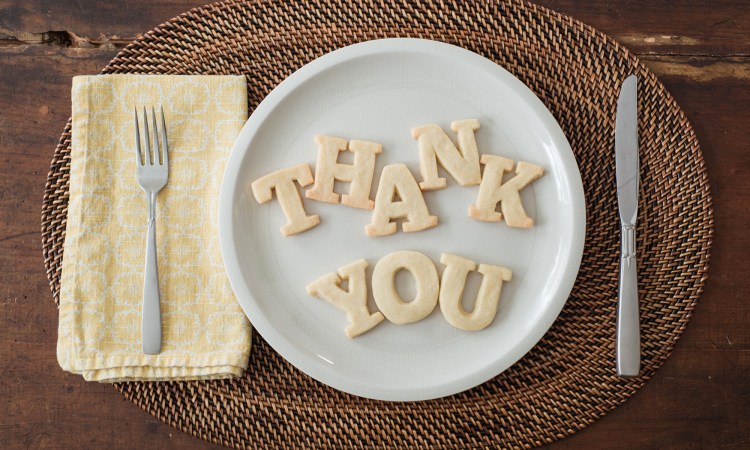
These five different exercises — all from TED speakers — can help you add more thanks to your life.
Feel free to do the challenges in any way that suits you, whether it’s in back-to-back days or spread out over weeks or months. Then, if some of them resonate with you more than others, focus on those and save the rest for another time.
The key is discovering the practices that increase the gratefulness in your life. Enlisting a gratitude buddy — someone else who will do these exercises at the same time as you so you’ll able to share your experiences — can help, too.
Challenge #1: Take a photo every day of something you’re thankful for.
In 2008 Hailey Bartholomew, who lives in Queensland, Australia, was struck with a bone-deep case of the blahs. “I had two healthy kids, a lovely partner, but I just did not feel anything for my life.” she recalls in a TEDxQUT Talk. Bartholomew went to a counselor, who asked her to do this exercise for 10 days: Take 10 minutes at the end of every day to reflect on the things she was grateful for, and write them down. This activity led her to notice moments and objects she’d have otherwise missed. At the end of 10 days, she decided she wanted to continue — but with an important twist. “I needed a lot more of that,” she says. “Being a photographer, I decided I was going to do a photo a day for a whole year.”
Bartholomew took photographs of the sights that stirred her gratitude — the color green, her favorite umbrella, weeds blowing in the wind, a bug perching jewel-like on her daughter’s shirt. But when she zoomed in on an object and the appreciation it aroused in her, something else happened in her: She found herself looking beyond her preconceptions and stale stories.
Take her husband. She felt he wasn’t romantic — he didn’t take her on dates, buy her flowers, or enact other known tropes. One day, she was trying to figure out the subject for her daily gratitude photo. “I was looking around the room, and then I saw my husband serving dinner,” she says. “In the corner of my eye, I watched as he put the biggest piece of pie on my plate, and I was like, ‘Whoa’ … And he was doing that every day — he was putting me fully first. But I was not seeing it because I was not looking.”
What good things in your life would you see if you just took the time to look? This particular challenge has an obvious perk: Whenever you need a reminder of what really matters to you , you’ll have your photos to look back on.
Challenge #2: In your transactions with cashiers, baristas and others, take the time to look them in the eye and really thank them.
“Gratitude is not an emotion that comes naturally to me,” writes AJ Jacobs in this excerpt from his book Thanks A Thousand. “My innate disposition is moderately grumpy, more Larry David than Tom Hanks.”
A few years ago, Jacobs — who is based in New York City — set out on a quest to thank everyone behind one thing in his life that he couldn’t function without: his daily coffee. He thanked the farmers, the person who designed the disposable cup, the truckers who transported the beans, and many, many others.
Early in his journey, Jacobs went to his local coffee shop to thank Chung, the barista who served him most days. In a TED Talk, he says, “Chung has had people yell at her until she cried, including a nine-year-old girl who didn’t like the whipped cream design that Chung did on her hot chocolate … But Chung said that the hardest part is when people don’t even treat her like a human being. They treat her like a vending machine. They’ll hand her their credit card without even looking up from their phone. And while she’s saying this, I’m realizing — I’ve done that. I’ve been that a-hole. At that moment, I pledged: When dealing with people, I’m going to take those two seconds and look at them, make eye contact … That little moment of connection is so important to both people’s humanity and happiness.”
Note: Jacobs says both people. Because when we’re busy treating someone like they’re a vending machine, we’re not experiencing our own humanity either. The next time you get ready to make eye contact with a barista or cashier and thank them, consider also doing one or more of the following: remove your headphones or earbuds, smile, offer a sincere compliment.
Challenge #3: Put up gratitude “stop signs” in your life.
Many of us spend our lives chasing after happiness — searching for the people, jobs, possessions and/or philosophies that will lead us to contentment. After we get there or get enough of those things lined up, we’ll have all the time in the world to be grateful. Right?
Nope — we’ve got the relationship between happiness and gratitude backwards, according to Benedictine monk and spiritual teacher David Steindl-Rast. In a TED Talk, he asks, “We all know quite a number of people who have everything … and they are not happy because they want something else or they want more of the same. And we all know people who have lots of misfortune, misfortune that we ourselves would not want to have, and they are deeply happy … Why? Because they are grateful. So it is not happiness that makes us grateful. It’s gratefulness that makes us happy.”
Br. Steindl-Rast believes that being grateful is as easy as crossing the street — and it consists of the same three steps: “Stop. Look. Go.” He adds, “But how often do we stop? … We have to get quiet. And we have to build stop signs into our lives.”
As an example, he recalls, “When I was in Africa some years ago and then came back, I noticed water. In Africa where I was, I didn’t have drinkable water. Every time I turned on the faucet [after I returned], I was overwhelmed. Every time I clicked on the light, I was so grateful. It made me so happy. But after a while, this wears off. So I put little stickers on the light switch and on the water faucet … I leave it up to your own imagination. You can find whatever works best for you, but you need stop signs in your life.”
You can put up the kinds of signs he suggests, but you could also “stop” to take photos of the things that provoke gratitude as Hailey Bartholomew does. Or, you might pick a point on your daily commute to “stop” and take note of something you appreciate. Maybe you could set your phone to buzz during the day, and let that be your prompt to survey your surroundings and your life for what’s good. (Br. Steindl-Rast is the cofounder and senior advisor to A Network for Grateful Living, and there are several other gratitude practices on their website.)
Ready to be grateful? Stop. Look. Go.
Challenge #4: Write a eulogy for a loved one — while they’re still alive — and give it to them.
When Keka DasGupta was 17, her life was punctuated by tragedy. Her father was burned in an accident, and he passed away two weeks later. She never had a chance to tell him what he meant to her before he died.
DasGupta, an Ontario, Canada-based marketing and PR strategist, didn’t want to experience that same regret with her mother, whom she’s very close to. In a TEDxWindsor talk, she recalls, “One day, I sat down and I wrote her a living eulogy. In it, I poured my heart out about the things that I admired about her the most, the way that she impacted my life, the things that I saw from her. Then I gave it to her.”
DasGupta didn’t receive an immediate response, and when she next saw her mom, she found out why. Her mother said, “I wanted to call you, but to be honest, I was so overcome by joy … I wanted to run out the front door and shout out to the world and say, ‘Look at this! Look at what my daughter wrote for me!’”
Think of that phrase her mother used: “Overcome by joy”. Wouldn’t it be great to cause someone to feel that? Start writing a eulogy.
Challenge #5: Be honest about the thanks you’d like to hear from the people in your life.
One day, southern California therapist Laura Trice had an insight about herself. While she had no problems asking for exactly what she wanted in much of her life — shoes in her size and not a size bigger or smaller, a steak cooked medium rare and not one that was medium or rare — she didn’t do the same with the thanks or praise she received. Instead, she accepted any scraps that came her way and also accepted when there were no scraps at all.
When she looked around, she saw that many of us do this. In a TED Talk, she says, “I know a gentleman, married for 25 years, who’s longing to hear his wife say, ‘Thank you for being the breadwinner so I can stay home with the kids,’ but won’t ask.” She thought about what kept her from stating her needs, and explains, “It’s because I’m giving you critical data about me. I’m telling you where I’m insecure … Because what can you do with that data? You could neglect me. You could abuse it. Or you could actually meet my need.”
Of course, not everyone is so reticent. Trice adds, “I know a woman who’s good at this. Once a week, she meets with her husband and says, ‘I’d really like you to thank me for all these things I did in the house and with the kids.’”
Try this out with the people you’re closest to: your family and your friends-who-are-essentially-family. And while you’re telling them what you want to hear, be sure to ask them what they’ve wanted you to say to them.














